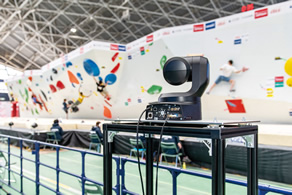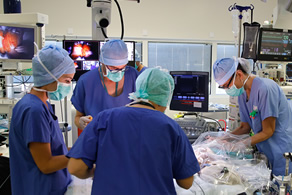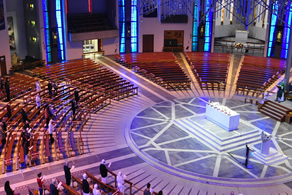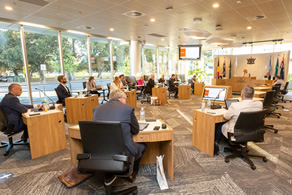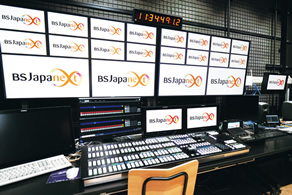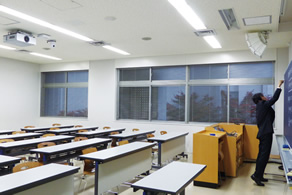
PTZ Camera Systems
Technology
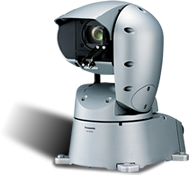
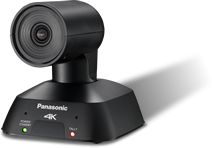
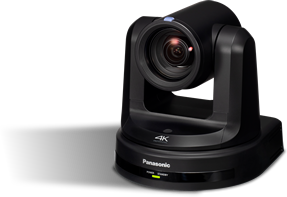
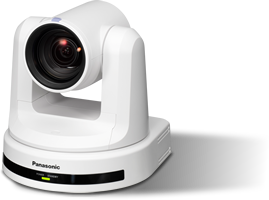
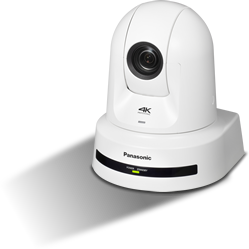
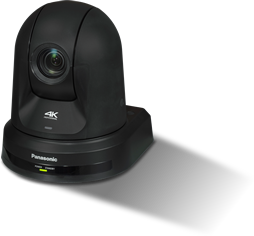
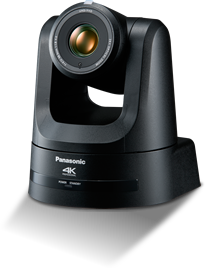
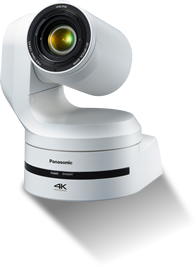
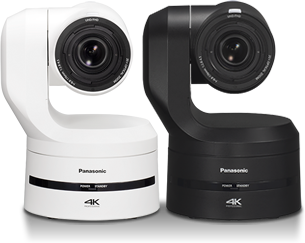
* Based on Futuresource PTZ Camera Report 2020.
Panasonic is No.1 PTZ Camera Value brand in worldwide from 2017 to 2019.
Acting as a Small Professional Camera Operator to Meet Expectations
— Facing Customer's requirement and evolving together —
Panasonic's concept of “Shooting Beautifully” is a prerequisite to enabling natural camera work as if shot by a professional Camera Operator. Our thoughts on development are the same with PTZ cameras that require remote operation. We will continue to be particular about every little detail such as the pan-tilt performance, vibration correction, image quality and operation response, incorporate industry-leading technologies and create PTZ cameras that will lead the industry.
Even after conducting our business, we will provide after-sales follow-ups and updates in order to build better relationships with each other. We will continue to always work closely with our customers to develop our products.
Panasonic PTZ Camera's
Four Core Technologies
Picture Quality
Panning × Vibration Correction × Lens
Smooth and natural movementsEasy Operation
Remote Camera Controller × Preset × Installation Properties
Easy installation and easy-to-use designSystem Flexibility
Compatible with Cutting-edge Technology
Achieves flexible operationReliability
Strict Design and Management Standards
High-quality products that support professionals

* Based on Futuresource PTZ Camera Report 2020. Panasonic is No.1 PTZ Camera Value brand in worldwide from 2017 to 2019.
Technology 1
Picture Quality
Panning × Vibration Correction × Lens
Pursuit of Smooth and Natural Movements
Panasonic's PTZ cameras combine lenses and video processing cultivated in the development of broadcast cameras and in addition to improving the camera performance, realizes detailed panning technology. Natural camera work is achieved with the smooth panning and highly accurate vibration correction.
We have combined the vibration correction according to the movement of the camera with lens and video processing cultivated in the development of studio cameras and system cameras. Thanks to these technologies, it is possible to create the same natural movements shot by professional Camera Operators.
Panning Technology: Motor and gears that control delicate movements
Motors and gears play an important role in the panning speed control. With a gear-driven PTZ camera, the rotation angle is sensed with high accuracy to make the rotation of the motor smoother. Also, the gears that were created with high precision eliminate speed unevenness.
Furthermore, we achieved a smooth response and high accuracy that exceeds the gear type with the New Direct Drive System with no gear configurations that was newly developed for the AW-UE100.
Gear Mechanism Design Optimized for Each Model
Panasonic's gear mechanism is optimally designed for each PTZ camera model. We are independently developing various gear system mechanisms according to the requirements for accuracy, responsiveness and quietness of each model by utilizing precision equipment design knowhow and high-precision machine manufacturing technology.
Panasonic's Gear Design Concept
- — Backlash* removal mechanism that combines high position reproducibility and responsiveness —
- — Fusion with servo motor control technology that increases accuracy
and responsiveness according to the gear configuration —
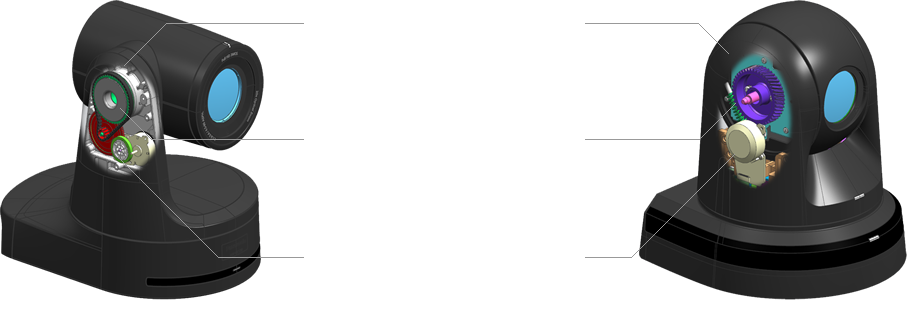
* Backlash... Refers to "gaps" and "play" intentionally provided in the direction of movement when a pair of gears mesh with each other and move.

New Direct Drive System
The industry's first*1 4K professional-use PTZ camera (AW-UE100) equipped with a Direct Drive (D.D.) System.
While the conventional D.D. System is highly accurate, it was said that it was difficult to control in the ultra-low speed range, but thanks to Panasonic's unique technology, we have succeeded in realizing stable and smooth movements.
High position reproducibility and smooth movements up to ultra-low speed have been realized due to the unique control algorithm that detects the rotation angle of the D.D. motor with high accuracy and provides feedback. The smooth movement of the D.D. motor is directly transmitted to the camera without being affected by the backlash*2 of the gear, and enables users to shoot beautiful panning videos even in the ultra-low speed range.
Mechanism of the Direct Drive Motor
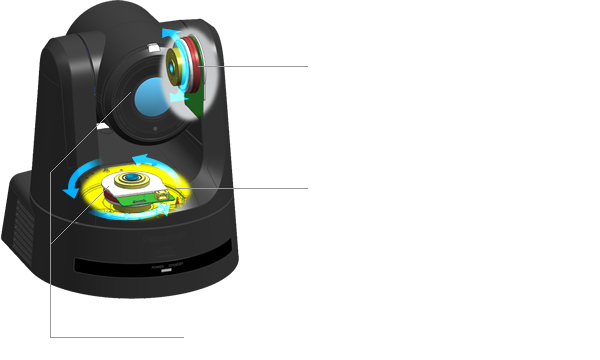
Stable and Smooth Movements
*1: According to Panasonic research as of August, 2020.
*2: Backlash... Refers to "gaps" and "play" intentionally provided in the direction of movement when a pair of gears mesh with each other and move.
Target product AW-UE100W/K
Vibration Correction
The vibration control technology for consumer cameras that we have accumulated knowhow of for over 30 years is applied the PTZ cameras. In addition to suppressing vibrations, we have repeated various trials and errors to take realistic images, and pursued a control method that is not unnatural.
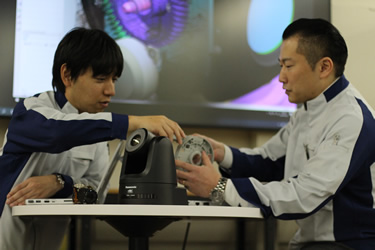

OIS (Optical Image Stabilization) and EIS (Electronic Image Stabilization)
Vibration correction for panning. Developed to support vibrations in the direction of the rotation in addition to vibrations from up, down, left and right. We have performed further rigorous tests to deliver a high-quality camera.
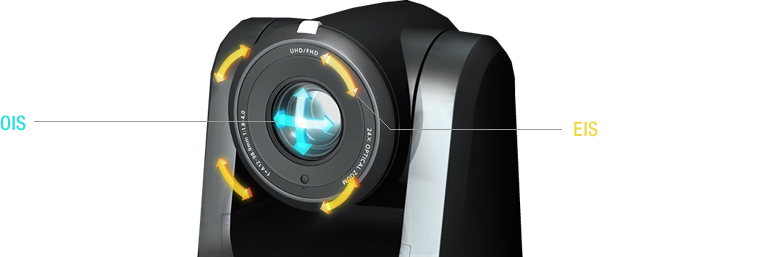
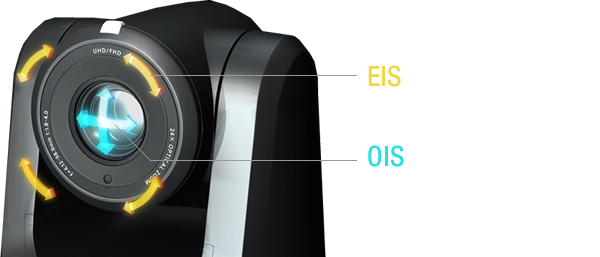
OIS & EIS Hybrid
Target product AW-UE100W/K
Lens
The lens performance of each of Panasonic's lenses is adjusted by the human eye and an automatic adjuster.
Even when combined with a studio camera or cinema camera, it is possible to record with comparable image quality to support low-cost, high-quality content production.
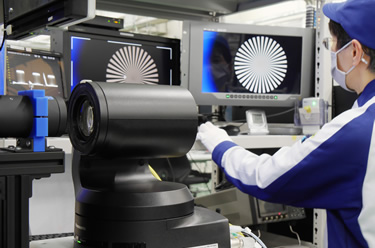
Lens Performance Adjustment Technology
Lenses are very delicate items. Before assembly the lenses and parts are cleaned with ultrapure water to remove foreign matter.
Also, because the lens is made by processing glass, there will be a slight difference in individual shapes. To fill this gap, optimal adjustments are made for each lens (tilt/decenter correction) to maximize the lens performance.
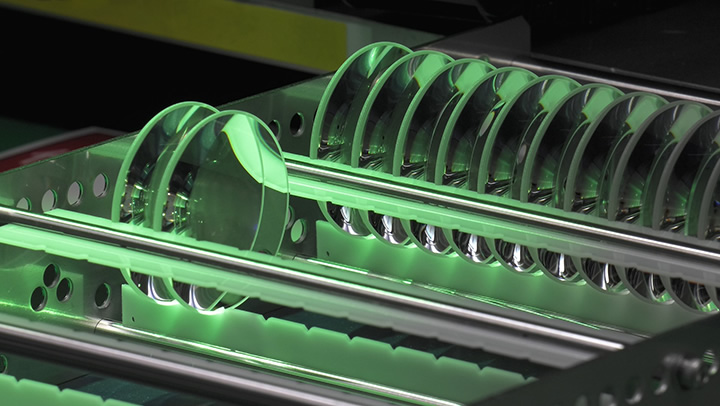
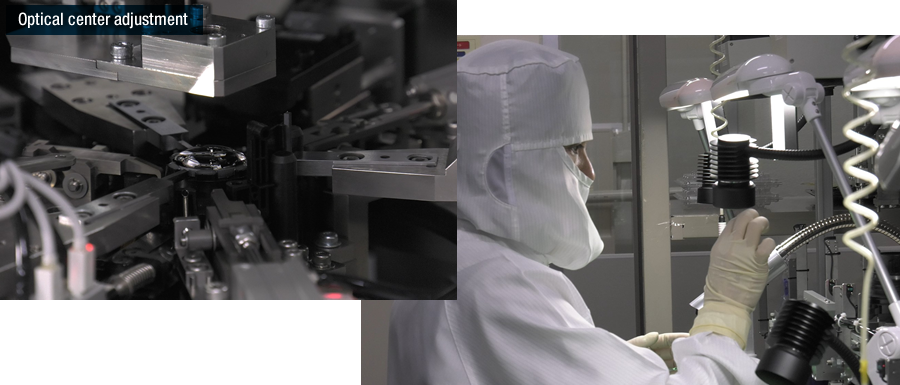
Visually check each lens one by one.
Technology 2
Easy Operation
Remote Camera Controller × Preset × Installation Properties
Easy Installation and Easy-to-use Design
Panasonic's PTZ cameras feature the preset memory function that can accurately stop at the control position and can be easily and stably operated with the intuitive remote controller design. Designed to reduce the complex installation process and costs at the time of introduction.
Remote Camera Controller Operability
Panasonic's remote camera controllers are developed to enable easy operation and long-term use by users. Immediacy and certainty are required on-site, so they have been designed with consideration to the placement of levers and buttons in the position of the user's hands. Furthermore, the arrangement of up/down/right/left levers and iris focus button can be switched, so it can be customized to suit your control style. To make it easier to incorporate it into the system you are using now, it has a wide range of compatibility from the latest models to successive models and devices of other companies.
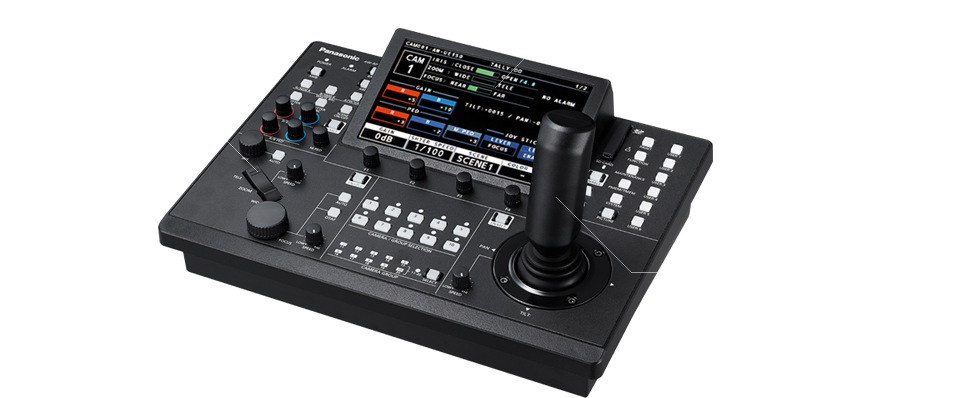
Target product AW-RP150GJ

Technological Itinerary of the Remote Camera Controller
Panasonic identifies on-site problems of customers and outputs solutions to our products. We are constantly growing based on requests and knowhow up until now.
Evolved points
 Multi-function Controller
Multi-function Controller


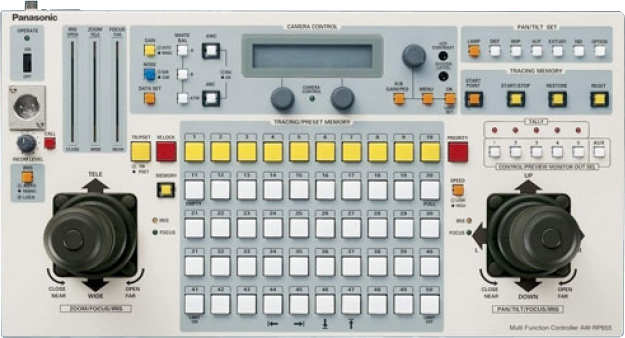
 Remote Camera Controller
Remote Camera Controller


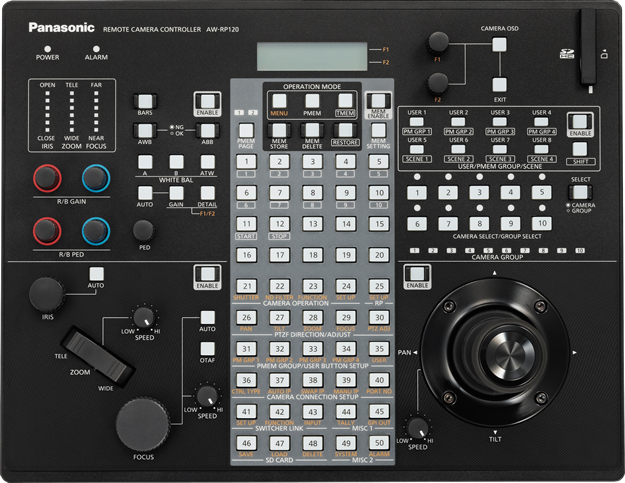
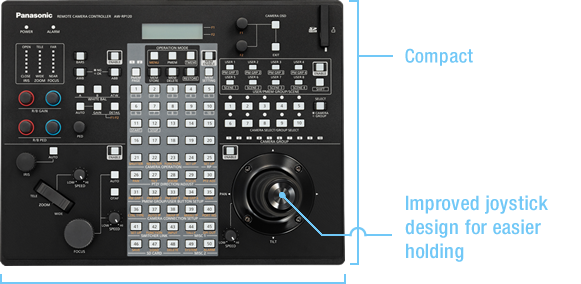
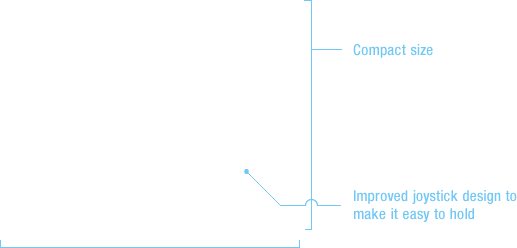
 Remote Camera Controller
Remote Camera Controller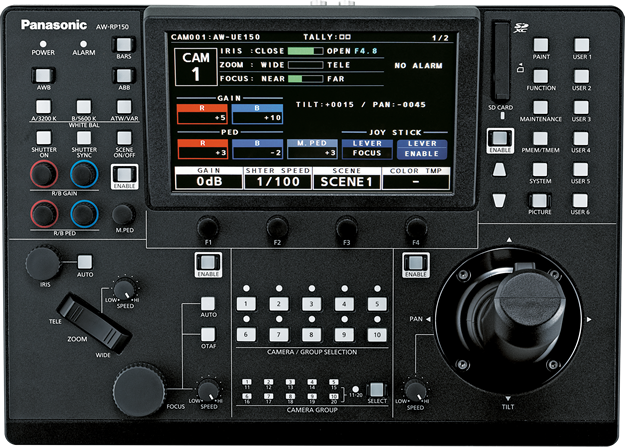
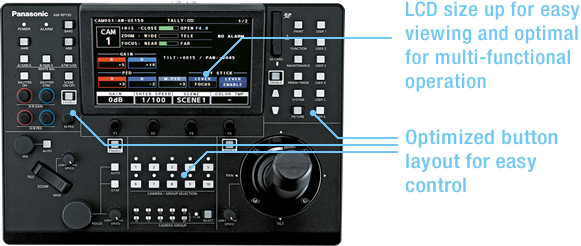
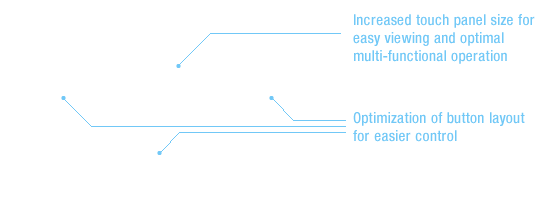
Accuracy of the Preset Memory Function
The camera can be pointed with almost no deviation in the preset angles. Achieves stable, high-quality shooting without correction by the Camera Operator.
Stable Zoom in
Easy Installation
Panasonic's PTZ cameras can be installed anywhere. Thanks to the compact size that can be operated with fewer cables, you will not have to worry about the system environment and space. Furthermore, since the mounting top plate is the same one used in the past, it is easy to replace. (The top plate is attached to the main unit.) This contributes to cost reduction by shortening the camera setting time.
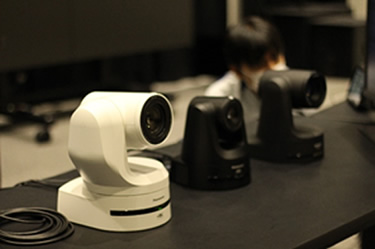

EasyIP Setup Tool Plus
Software developed to meet customer needs. Easily set camera detection and network functions with a single PC screen from the setup stage. It also identifies cameras that need to be version upgraded, and downloading firmware and upgrading versions can be conducted with an app to save the hassle of maintenance and management.
Firmware Updates Can Also Be Centrally Managed
Target product EasyIP Setup Tool Plus
Technology 3
System Flexibility
Compatible with Cutting-edge Technology
Achieves Flexible Operation
The IP technology cultivated with Panasonic's security cameras is applied to the PTZ camera. Up to 200 cameras can be controlled with a single remote controller (serial, IP control). Also, by supporting a LAN connection, restrictions on the distance between the shooting site and settings and operations can be resolved, which contributes to improving work efficiency of content production and reducing costs for system introduction. We have introduced the power supply using a LAN cable (PoE technology) ahead of the industry, and have improved installability by proposing a one cable solution that combines IP technology transmission (video/control).
The number of supported control protocols is one of the highest in the industry. We partner with many software development companies to make regular updates to reflect the voice of our users. Therefore, the latest features are always included in Panasonic's PTZ camera, and we will continue to provide flexible shooting.
IP Technology
One Cable Solution

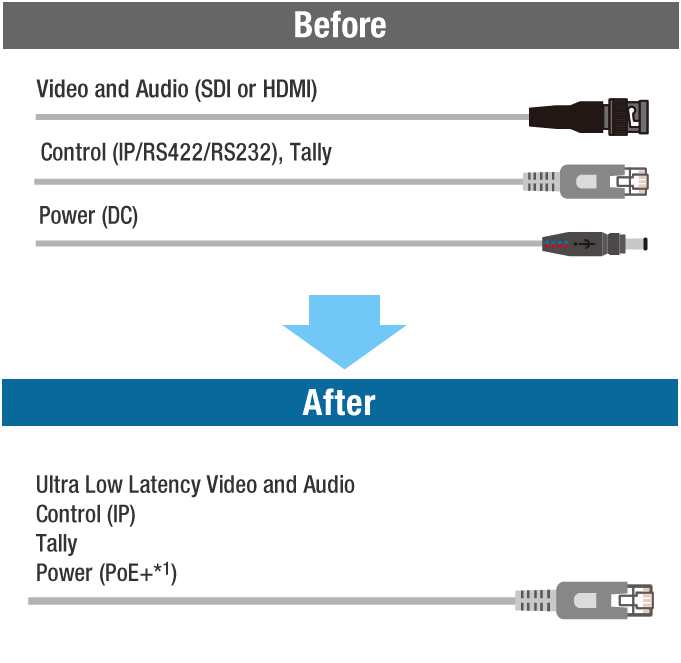
Supports Various Communication Protocols
| Video streaming protocol | RTP/RTCP over RTSP, RTMP, RTMPS, SRT, MPEG2-TS over UDP, NDI®|HX, High bandwidth NDI® |
|---|---|
| External device linkage protocol | FreeD, TSL5.0, SNMP |
As of February 2021
* For details, check each product page.
*1: Power over Ethernet Plus, IEEE 802.3at
* NDI® is a new live video production workflow support protocol for IP use developed by NewTek in the United States. In this instance, NDI® is used to indicate high bandwidth NDI®.

Auto Tracking Software Key
By installing the automatic tracking software to high-performance servers and PCs, it is possible to easily build an automatic tracking system. Because there is no need to add new equipment such as a position detection sensor, it is easy to configure the system and the initial costs can be reduced. It automatically begins tracking after detecting the target subject, so you will be freed from the hassle of operation.
Technology 4
Reliability
Strict Design and Management Standards
High-quality Products that Support Professionals
At Panasonic, parts are assembled in a strict clean room to preserve the high level of professional quality. In the quality/durability tests, we strive to inspect and improve quality from the user's point of view.
Lens Quality Control
The assembly of camera lenses is carried out in a clean room with a thoroughly controlled manufacturing environment to prevent dust and dirt from getting inside the equipment. This is because if even a small amount of dust adheres or mixes inside the lens that reflects high-definition objects, it may occur of quality deterioration and camera defects.
Strict Clean Room
The assembly of Panasonic’s lenses is carried out in a clean room. Particularly in the assembly area, work is carried out in a class 100 high level environment (similar level to semiconductor factories). The assembly station is constantly supplied with clean air through a HEPA filter.
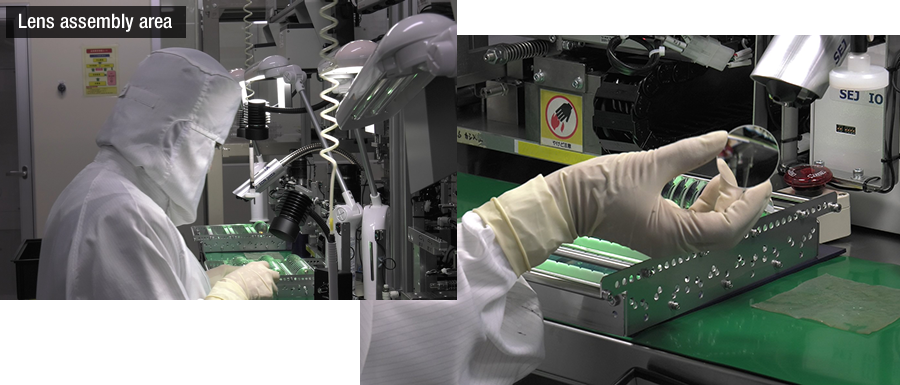
The dust adhered on the lens is thoroughly removed with air.
Required Cleanliness Class
The clean room cleanliness is expressed as the number of fine particles (amount of debris in the air) in 1f3 (cubic feet ≈ 28.2 liters). In other words, the lower the cleanliness class, the cleaner the environment is.
Remote Controller Quality Control
The joystick part of the remote controllers is checked to make sure it does not break even if it is used for a long time. We conduct tests to confirm that it can be used without problems even if you rotate the joystick hundreds of thousands of times. Panasonic's products are developed so that they can be used for at least eight years (one use time is assumed to be eight hours). Also, assuming the industries where PTZ cameras are used, we careful so that they can be used in any scene without any problems.
Joystick Endurance Test
After rotating them with a dedicated machine, we conduct a test to see whether the rubber part of the joystick breaks.
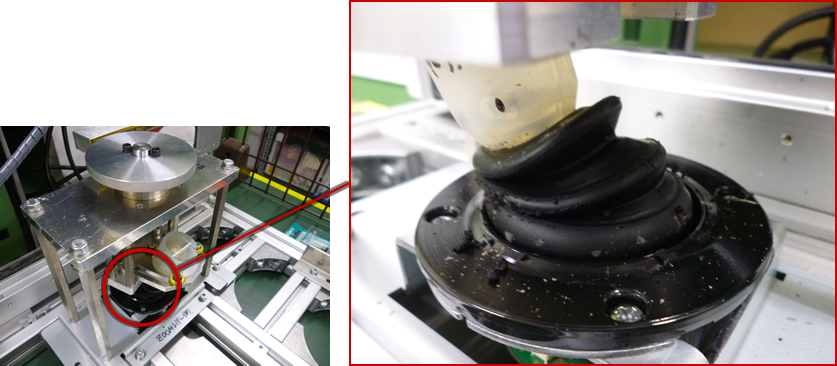
Joystick Harness Twist Test
After rotating them with a dedicated machine, we conduct a test to see if any problems occur with the harness that passes through the moving parts of the joystick.
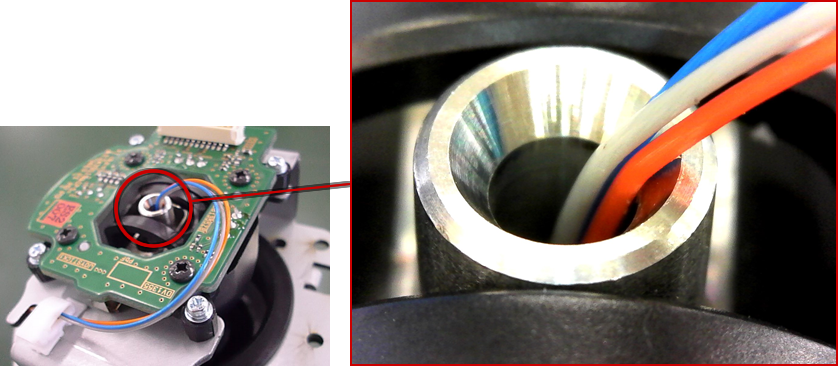
Technological Itinerary
We will continue to refine PTZ's core technology and develop products that will make worksites more convenient by understanding the needs of customers around the world.
Two-piece Camera









IP Control
- AW-HE50S/H





Slim and Compact
- AW-HE120W/K









Video over IP w/ Control and PoE support
- AW-HE130W/K
- AW-HE40SW/SK
- AW-HE40HW/HK




4K30p support
w/ 3G SDI







4K 60p/50p*1 support w/ 12G-SDI










The Middle Range Model has been Fully Upgraded




*1: Actual output format is UHD(3840 x 2160) 56.94p/50p.
*2: Based on Futuresource PTZ Camera Report 2020. Panasonic is No.1 PTZ Camera Value brand in worldwide from 2017 to 2019.
* NDI® is a new live video production workflow support protocol for IP use developed by NewTek in the United States. In this instance, NDI® is used to indicate high bandwidth NDI®.
Award
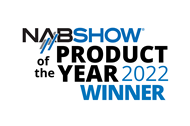
Won 2022 NAB Show
Product of the Year Award
TV Technology Announces
NAB Best of Show Awards
iF DESIGN AWARD 2021
Award-winning Product AW-UE150, AW-UE100, AW-UE80 and AW-UE50/40
Message
from Developer and Planner
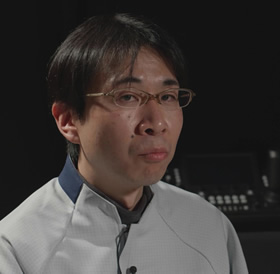
Munenori Miyaji
PTZ Camera Project Leader
Product Design Group
Media & Entertainment Business Div.
Panasonic Corporation
Our recent PTZ camera represents what was sublimated during the development of the original AW-HE100. We put three main elements into products when developing them.
First, this is a camera for taking pictures. So we sought natural color and color reproducibility. Accordingly, adjustment functions are comparable to high-end studio cameras.
Second is moving/stopping reproducibility. It has a robotic mechanism so it must be very accurate, stop crisply and move smoothly.
Third is total system cost reduction by workflow innovation using PTZ cameras. We switched from serial to IP control, and to one-cable IP solution for video, control and power. We have been adopting the latest technologies, such as NDI®|HX and fiber solution, which realize easier installation and simpler cabling.
* NDI® is a new live video production workflow support protocol for IP use developed by NewTek in the United States. In this instance, NDI® is used to indicate high bandwidth NDI®.
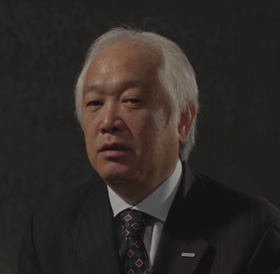
Kazunori Masamura
Professional AV Planning
(Product Planning)
Media & Entertainment Business Div.
Panasonic Corporation
Panasonic has been offering box cameras and pan-tilt heads since before.
In 2008, we used this know-how to develop a product integrating a lens, a camera and a pan-tilt head.
It has been 10 years since our PTZ cameras were first launched.
We make efforts in listening carefully to voices of customers and introducing better products that meet customers' expectations.
Case Study
Developing from the Voice of Customers
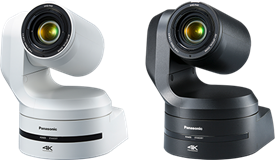


SRT Introduction
In response to growing demand for remote video production using a public line as IP conversion continues to progress, we adopted SRT, which has been gaining momentum in the industry.
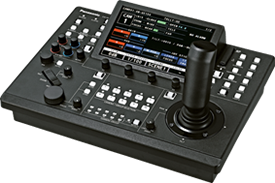
Improved Operability of the AW-RP150GJ
In response to customer requests for easy and intuitive operation, we adopted a 3D joystick (can be operated with one hand with the PTZ). Furthermore, we also supported 3rd party device control such as robotics.
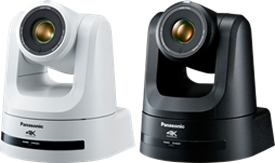
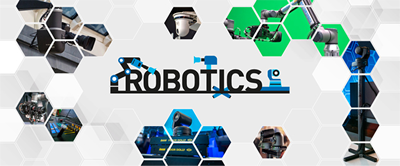
Robotics Systems
To produce attractive and engaging content more efficiently, Panasonic support Robotic camera systems and providing smooth camera movements that can be created and managed remotely.
*availability may differ depending on country.
For more information, please visit the website below.
For USA For Europe

SMPTE ST 2110 compatible
We responded to requests from users in the growing demand for using PTZ cameras in the increasingly IP-based broadcast industry, we adopted SMPTE ST 2110, which has been gaining momentum in the industry.
JPEG XS compatible
In response to the increasing demand for the utilization of large-volume, high-quality video in line with the development of high-speed telecommunications, we adopted JPEG XS.
* NDI® is a new live video production workflow support protocol for IP use developed by NewTek in the United States. In this instance, NDI® is used to indicate high bandwidth NDI®.
We have developed an integrated camera based on the technology of the turntable of the two-piece camera. Since the beginning, Panasonic products have been active in wedding halls and parliamentary halls.
The AW-HE60 is the industry's first model equipped with a video output function for IP transmission.
With the AW-HE2, we have developed a compact model with a wide angle of 95 degrees that supports USB video output.
V-log Compatible
In response to voices from the field of wanting to use a remote camera with the same workflow as a production camera, we support shooting with the V-Log gamma equipped onto Panasonic's cinema camera VariCam. Together with HDR/BT.2020 compatibility, it enables shooting in a wide dynamic range and contributes to expanding the range of video expression.
FreeD Compatible
In response to needs from Spanish TV stations, we have improved performance so that it can also be used for VR broadcasting. As a global company, we quickly respond to the latest technologies in each country.
New Direct Drive System
We have developed a gearless motor by applying the servo motor technology for broadcast VTR. Panning is possible at a low speed, and we have created a technology that balances the good points of gears and motors.
The New 5 PTZ embodied the very best of Panasonic PTZ
A camera that realizes even higher quality image communication at online lessons, conferences and events., etc. has been developed.
The technology of the high-end model has been equipped onto the middle range model to expand and update the entire remote camera lineup, and we have made it possible to provide image technology to customers in a wide range of fields.
- New Direct Drive System*1
New Direct Drive System based on Panasonic's own technology for smooth vertical and horizontal directions. With clear images and dynamic image production that cannot be obtained with fixed-point angles, it is possible to improve the quality of online communication and enhance the sense of presence even when not face-to-face.
With the high quietness of the proprietary direct drive motor (NC25 or less*2), it is possible to behave in the same way as when communicating face-to-face without worrying about the camera. - Compact Design
The small housing and bottom design allow it to be installed in places that are difficult for people to reach, such as ceilings and walls. - 4K compatible*3
- FreeD*4, High Bandwidth NDI® and NDI®|HX version 2*1*5, SRT protocol compatible*1
- Online conferencing application compatible*6
*Check each of the product pages to see the features that support each device.
*1: Not installed in the AW-UE20W/K and AW-HE20W/K.
*2: According to CNS research.
*3: AW-HE20W/K is FHD output instead of 4K.
*4: Only AW-UE80W/K supports FreeD protocol.
*5: NDI® is a new protocol developed by NewTek, Inc. that supports IP video production workflow. NDI® is a registered trademark of NewTek, Inc. in the United States.
In this instance, NDI® is used to indicate low latency with high bandwidth NDI®, NDI®|HX version 2 is used to indicate high efficiency low bandwidth NDI®|HX version 2. NDI® is a new protocol developed by NewTek, Inc. that supports IP video production workflow. NDI® is a registered trademark of NewTek, Inc. in the United States.
*6: Scheduled to be gradually compatible.
Industry's first*1 SMPTE ST 2110 standard*2 compatibility
The first PTZ Camera to support the SMPTE ST 2110 standard for video transmission over IP networks*1. By constructing an IP-based studio system in combination with the IT/IP platform "KAIROS" or AK-UC4000/AK-UCU600/AK-NP600, it is possible to improve the efficiency of the video production site.
*1: As of October 2022, according to our research.
*2: Activation with the separately sold software key AW-SFU60 (released at the same time as AW-UE160) is required.
Equipped with newly developed PTZ mechanism
A new PTZ mechanism was developed to maintain the compact body while incorporating a large sensor/lens for high picture quality and system camera-level functions. The camera is quiet and does not disturb the model, and its high static accuracy provides a high operability that allows the camera operator to shoot exactly what he/she aims for.








